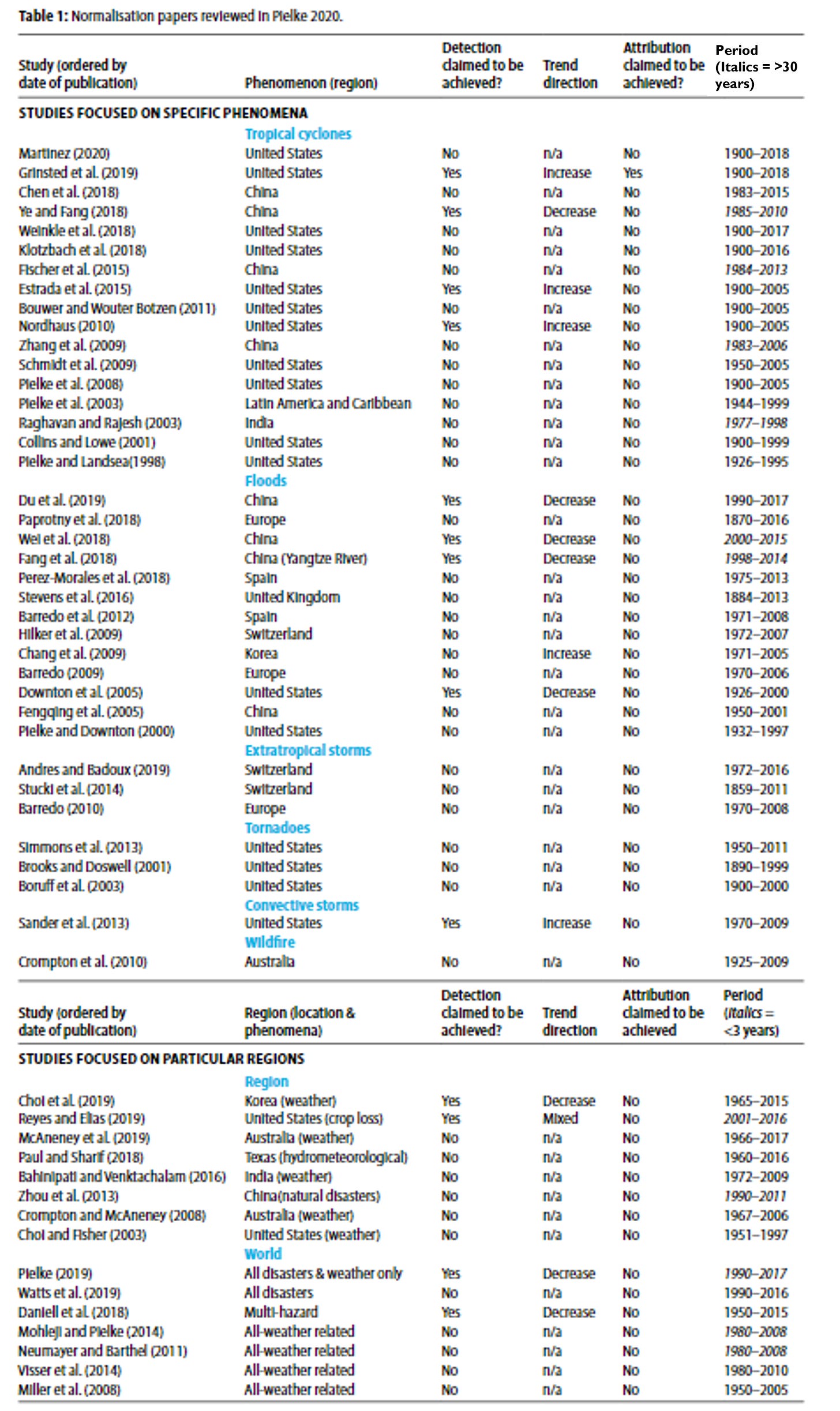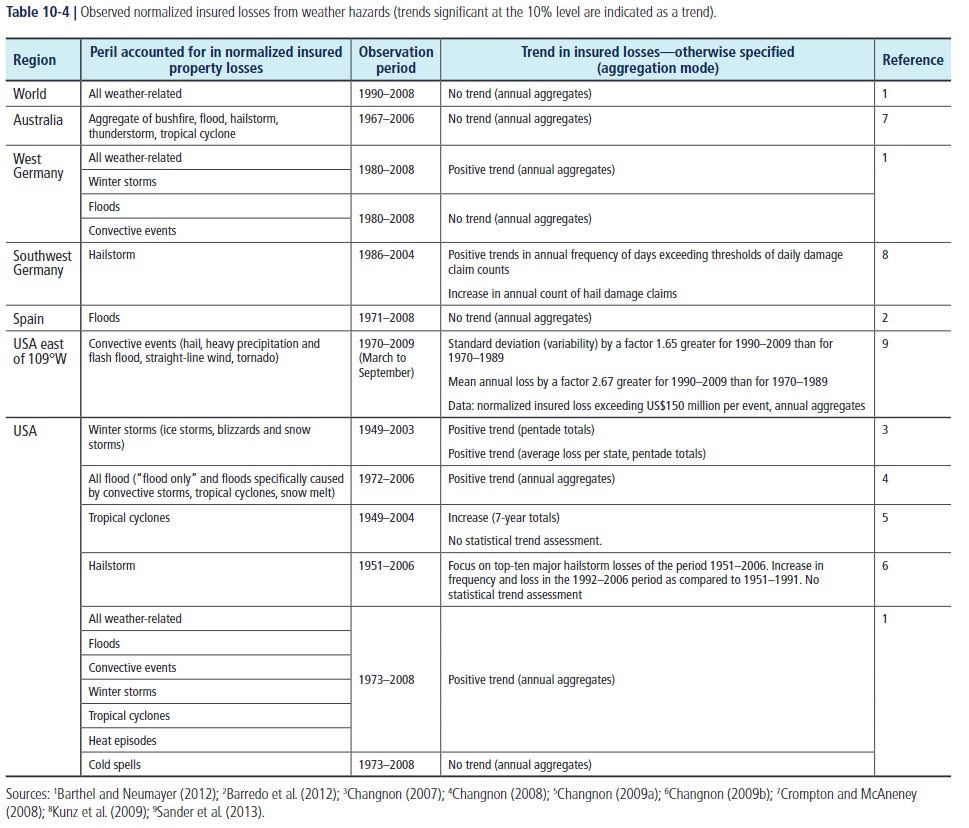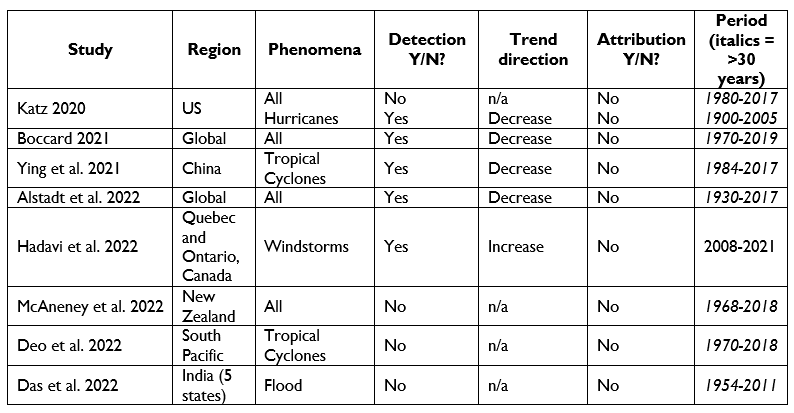Update: I’ve added this as Part 5 to the THB Series Making Sense of Trends in Disaster Losses. You can find quick links to all the THB Series in the menu bar above.
In 2020 I published a paper that surveyed the peer-reviewed literature on disasters and climate change which focused on a large family of methodologies called disaster normalization. I wrote the paper thinking that it would be useful to the work of the Intergovernmental Panel on Climate Change (IPCC) as it assessed the literature in preparation of its Sixth Assessment Report (AR6). Today, I update that literature review through today.
Here is the abstract to my 2020 review:
Nowadays, following every weather disaster quickly follow estimates of economic loss. Quick blame for those losses, or some part, often is placed on claims of more frequent or intense weather events. However, understanding what role changes in climate may have played in increasing weather-related disaster losses is challenging because, in addition to changes in climate, society also undergoes dramatic change. Increasing development and wealth influence exposure and vulnerability to loss – typically increasing exposure while reducing vulnerability. In recent decades a scientific literature has emerged that seeks to adjust historical economic damage from extreme weather to remove the influences of societal change from economic loss time series to estimate what losses past extreme events would cause under present-day societal conditions. In regions with broad exposure to loss, an unbiased economic normalisation will exhibit trends consistent with corresponding climatological trends in related extreme events, providing an independent check on normalisation results. This paper reviews 54 normalisation studies published 1998–2020 and finds little evidence to support claims that any part of the overall increase in global economic losses documented on climate time scales is attributable to human-caused changes in climate, reinforcing conclusions of recent assessments of the Intergovernmental Panel on Climate Change.
At the bottom of this post you can find a link to the full PDF of this paper, ungated for THB Pro subscribers.
In past assessments, the IPCC also surveyed the normalization literature — as it should given its direct relevance to our understandings of climate change and its possible impacts on human society.
Below is a summary table from the IPCC Fifth Assessment Report (AR5), summarizing the results of 9 studies that look at the inter-relationships of climate and societal trends in disaster losses and employing various normalization methods. The IPCC AR5 was clear in its conclusion on what this literature said: “loss trends have not been conclusively attributed to anthropogenic climate change.”
As a long-time expert in this area, I knew that the AR5 had missed some key literature and also that since the AR5 was completed, the number of normalization studies of had increased substantially.
So as a contribution to the work of the IPCC AR6 I prepared an updated review of the relevant literature, and that was the paper published in 2020, well in time for its inclusion in the AR6. I included in that review a summary table similar to the one included in the AR5. You can see a version of that table below — it is a big table because of the large number of studies in this area that were published since the AR5.

You can see in the table above that I use the IPCC’s framework for detection and attribution as part of the summary. I explain in my paper what these technical terms mean:
This review utilises the framework of detection and attribution of the IPCC. The IPCC defines ‘detection’ of a change in climate in statistical terms, typically based on trends documented on time scales of 30 years or longer, without explaining the reason for the observed change (IPCC, 2013). ‘Attribution’ seeks to identify causes of detected change, typically using climate models. This review of normalisation studies assesses whether reviewed studies make claims of detection (in normalised loss trends) and attribution (of any detected trends to changes in climate resulting from human causes).
Here is the bottom-line conclusion of my literature review:
The overwhelming majority of the literature reviewed here reports normalisation results that indicate no detectable trends in normalised losses on climate time scales.
I was very clear in my paper what these conclusions meant, what they did not, and their complete consistency with other recent major scientific assessments.
The lack of current detection or attribution associated with any of these variables in no way should be interpreted as evidence against the reality of human-caused climate change or its actual or potential influence on extreme weather events now or in the future. Finally, none of the claims made in this review of normalisation studies related to trends in extreme weather events are at odds with the assessments and far more in-depth literature reviews of the IPCC, USNCA, Krishnan et al. (2020), Lee et al. (2020), Cha et al. (2020) or Knutson et al. (2019).
Unfortunately, as recently documented by CLINTEL, the recent IPCC AR6 ignored both my literature review and almost all of the literature that I reviewed. Instead, the IPCC cherrypicked the one study that claimed (but did not assess) detection and attribution from among the 53 relevant studies, while ignoring the rest. In another section of the IPCC, it cherrypicked 2 studies — together cited dozens of times — suggesting an increase in normalized US hurricane losses while ignoring 5 others — with thousands of citations — that suggested no increase and another that argued for a decrease.
Apparently, it is true that you can lead a horse to water, but can’t make it drink.
Over the past few weeks, I have gone through the literature published since my paper came out in 2020, and I have identified 9 additional normalization studies, which I summarize in the table below. A bibliography with links to each paper can be found at the bottom of this post.
These studies add to the overwhelming conclusions already in the literature — Specifically, there is little evidence to support claims that changes in climate resulting from the emissions of greenhouse gases (or other causes) have resulted in detectable or attributable trends in disaster losses. There are now 62 relevant studies of various phenomena in regions around the world and 61 of them make no claims of attribution.
There is an overwhelming scientific consensus here, as strong as any assessed in the IPCC. Whether people choose to acknowledge or accept it is of course another matter.
If you are aware of other relevant literature, please share in the comments.
Bibliography
Alstadt, B., Hanson, A., & Nijhuis, A. (2022). Developing a Global Method for Normalizing Economic Loss from Natural Disasters. Natural Hazards Review, 23(1), 04021059.
Boccard, Nicolas. "Analysis of trends in disaster risk." International Journal of Disaster Risk Reduction 53 (2021): 101989.
Das, S., Sheth, A. N., Bansal, P., Chuah, J., & Wasson, R. (2022). A statistical comparison of flood-related economic damage in Indian states with reflections on policy implications. International Journal of Disaster Risk Reduction, 72, 102835.
Deo, Anil, Savin S. Chand, R. Duncan McIntosh, Bipen Prakash, Neil J. Holbrook, Andrew Magee, Alick Haruhiru, and Philip Malsale. Severe tropical cyclones over southwest Pacific Islands: economic impacts and implications for disaster risk management. Climatic Change 172, no. 3-4 (2022): 38.
Hadavi, M., Sun, L., & Romanic, D. (2022). Normalized insured losses caused by windstorms in Quebec and Ontario, Canada, in the period 2008–2021. International Journal of Disaster Risk Reduction, 80, 103222.
Katz, R. W. (2020). Statistical issues in detection of trends in losses from extreme weather and climate events. In Evaluating climate change impacts (pp. 165-186). Chapman and Hall/CRC.
McAneney, J., Timms, M., Browning, S., Somerville, P., & Crompton, R. (2022). Normalised New Zealand natural disaster insurance losses: 1968–2019. Environmental Hazards, 21(1), 58-76.
Ying, L., Haikun, Z., Dan, Z., & Qingqing, L. (2021). Spatial-temporal characteristic of tropical cyclone disasters in China during 1984−2017. 海洋学报, 43(6), 45-61.
Below, paid subscribers can download a full PDF of my 2020 review:
Pielke, R. (2021). Economic ‘normalisation of disaster losses 1998–2020: A literature review and assessment. Environmental Hazards, 20(2), 93-111.
Comments and shares welcomed!






